Your Guide to Hungarian Christmas Traditions

Nestled in the heart of Central Europe, Hungary stands as a testament to the rich tapestry of European Christmas traditions that have been cherished and preserved for centuries. As winter’s embrace tightens around its historic castles and the aroma of traditional dishes wafts through the chilly air, Hungary morphs into a festive wonderland, beckoning travelers and locals alike with its enchanting allure.
While many European nations have their own distinct holiday customs, Hungary offers a unique blend of age-old rituals and vibrant cultural celebrations during this special season. From the twinkling lights and ornate decorations that adorn bustling Christmas markets, to the heartwarming family customs passed down through generations, the Hungarian festive season is more than just a holiday—it’s a profound reflection of history, faith, and community spirit.
For those eager to dive deep into the heart of European Christmas traditions and experience a celebration brimming with joy, warmth, and magic, a Yuletide journey through Hungary promises memories that will last a lifetime.
Quick Summary
- Hungarian Christmas traditions are rooted in centuries of cultural heritage and are celebrated with joy and reverence throughout the country.
- Christmas Eve in Hungary is a time of reflection and celebration with family, and traditional dishes like fisherman’s soup and Hungarian poppy rolls grace festive tables.
- Mikulás (Saint Nicholas Day) is a beloved Hungarian holiday where gifts are exchanged and the spirit of giving is celebrated.
- Explore the enchanting customs surrounding the Hungarian Advent wreath and learn how Hungarians decorate their homes and Christmas trees during the holiday season.
- Experience the joy and warmth of Hungarian festive folk songs and carols that bring life to the holiday season in Hungary.
Hungarian Advent Wreath
The Advent wreath is an important part of Hungarian Christmas traditions, representing the four weeks leading up to Christmas Eve. Each Sunday before Christmas, a candle on the wreath is lit, starting with one and adding one each week until all four are burning on the final Sunday before Christmas. It symbolizes the waiting and preparation for the arrival of Jesus on Christmas Day.
The Advent wreath is typically decorated with pinecones, berries, and even small figurines representing the Nativity story. It is often placed in the center of the table during family meals, serving as a reminder of the upcoming holiday.
Another significant aspect of Hungarian Christmas traditions is the decorating of the Christmas tree. Families often decorate the tree on Christmas Eve, using handmade ornaments and decorations passed down through generations. The tree is typically decorated with traditional Hungarian ornaments, such as hand-carved wooden figures and hand-painted porcelain dolls. It is not uncommon for families to add edible decorations such as Szaloncukor, a Hungarian candy, and strands of popcorn. The tree is often topped with a star or angel, representing the Christmas story of the star of Bethlehem.
To add to the festive mood, some Hungarians also hang a Christmas wreath on their front door. This wreath is often made of pinecones and berries, with a candle in the center representing the light of hope and love during the holiday season.
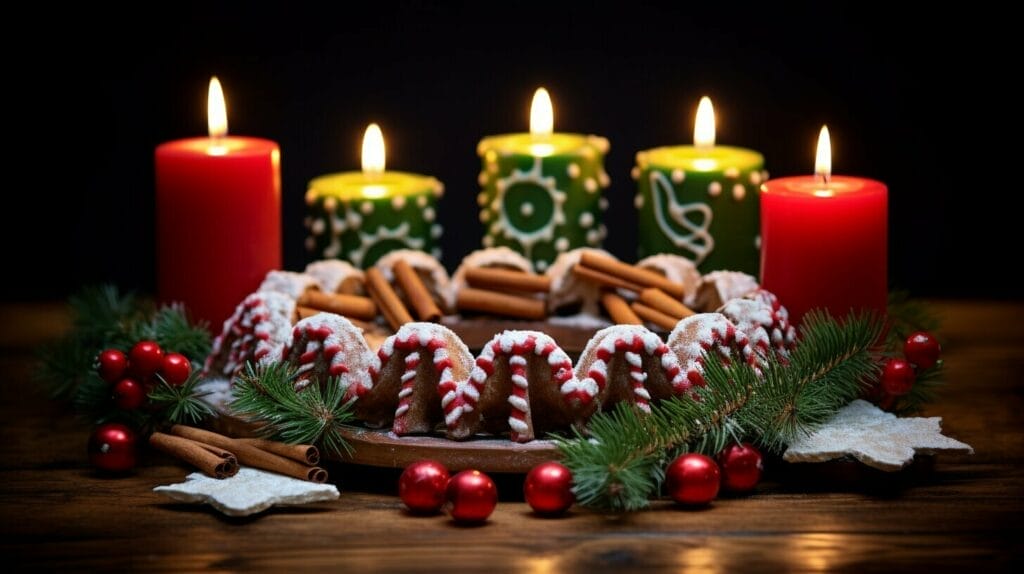
During the Advent season, many churches in Hungary also have special services and events, such as Advent concerts, to celebrate the coming of Christmas.
Hungarian Festive Folk Songs and Carols
Experience the joy and warmth of Hungarian Christmas with festive folk songs and carols. Hungarians have a rich cultural heritage of traditional melodies that celebrate the holiday season. From lively dances to soulful ballads, Hungarian festive folk songs and carols have a unique charm that will captivate your heart.
One of the most beloved Hungarian Christmas carols is “Karácsony, karácsony,” which translates to “Christmas, Christmas.” This cheerful song is sung by children, who dress up in festive attire as they go from house to house, spreading Christmas cheer in their neighborhood. Another popular carol is “Ég veled, kis Jézus,” which means “Farewell, little Jesus.” This song is usually sung during the Christmas Eve dinner, when families gather to exchange gifts, share a meal, and celebrate the birth of Jesus.
Join in the celebration by learning the lyrics and singing along to these delightful songs. Experience the magic of Hungarian Christmas through the enchanting melodies of festive folk songs and carols.
Festive Folk Dances and Traditional Attire
The festive season in Hungary is a time of joy and celebration, and nothing captures the essence of this more than the traditional Hungarian folk dances. These lively, vibrant dances are an important part of the cultural heritage of Hungary and are performed throughout the holiday season.
As you watch the Hungarian folk dancers move to the beat of the music, you’ll be swept away by the energy and joy they bring to the festivities. These dances are often accompanied by traditional Hungarian music, played on instruments such as the cimbalom (a type of hammered dulcimer) and the fiddle.
Hungarian Traditional Attire
The traditional attire worn by Hungarian folk dancers is an important part of the performance and adds to the authenticity of the experience. Women typically wear embroidered blouses, full skirts, aprons, and headscarves, while men wear snug-fitting trousers, waistcoats, and hats. The garments are often decorated with intricate embroidery, which is a testament to the skill and craftsmanship of Hungarian artisans.
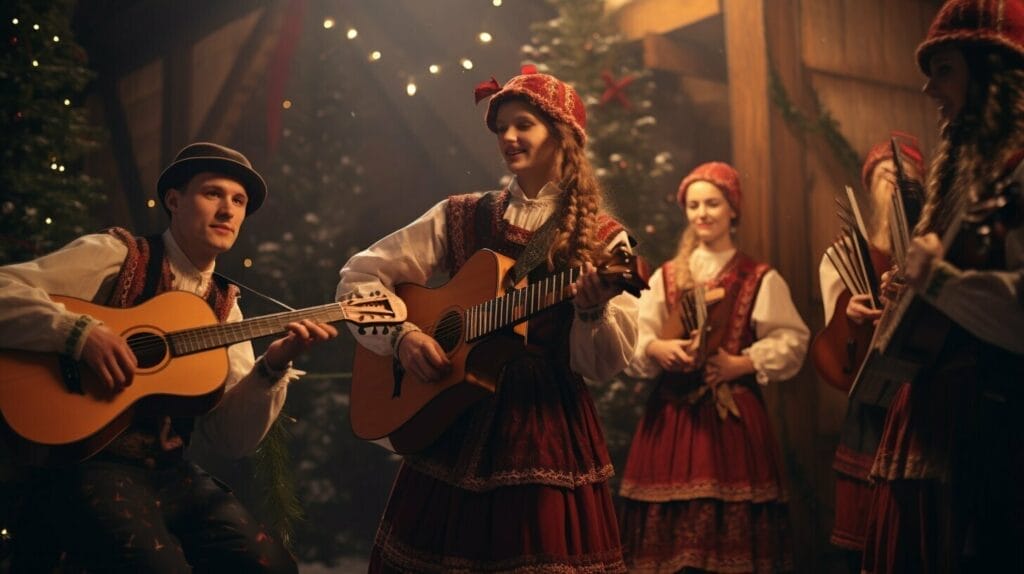
These traditional costumes are not just reserved for performances – they are often worn during the holiday season as a way of honoring Hungarian cultural heritage. You may even see locals dressed in traditional attire as they go about their daily business, adding to the festive atmosphere of the holiday season.
Whether you’re watching the Hungarian folk dancers perform or simply strolling through the streets, the traditional festive attire adds a touch of elegance and charm to the holiday season in Hungary.
Christmas Markets and Gift Giving
One of the most exciting aspects of the holiday season in Hungary is the gift-giving customs that are deeply ingrained in the culture. Hungarian families typically exchange gifts on Christmas Eve, which is considered the main event of the holiday season. It’s customary to wrap the gifts in festive paper and keep them under the Christmas tree until the evening.
But where do you find that perfect gift for your loved ones? Look no further than the vibrant Christmas markets that pop up throughout Hungary during the holiday season. These markets are abundant with a range of unique and handmade crafts, traditional holiday treats, and so much more.

Experience the magical atmosphere of these markets and browse through the many stalls to find the perfect gifts for your family and friends. With the flicker of candlelight and the aroma of spiced wine in the air, these markets create an enchanting and festive vibe that’s hard to resist.
Hungary, particularly its capital Budapest, is known for its festive Christmas markets. Some of the most famous Christmas markets in Hungary include:
- Vörösmarty Square Christmas Market, Budapest: As the oldest and most renowned Christmas market in the city, Vörösmarty Square becomes a festive hub from late November through the end of December. It’s known for its handcrafted goods, traditional Hungarian foods, and a grand Christmas tree.
- St. Stephen’s Basilica Christmas Market, Budapest: Located by the stunning St. Stephen’s Basilica, this market offers a unique backdrop with its illuminated cathedral. There’s also a skating rink for children and a light show on the facade of the basilica every evening.
- Deák Ferenc Street and Fashion Street, Budapest: These are the main shopping streets in Budapest and are beautifully decorated during the Christmas season. The festive atmosphere, combined with the high-end shops and boutiques, makes it a popular destination.
- Advent in the Buda Castle, Budapest: This market is situated in the historic Buda Castle. The ambiance is magical, with the castle providing a fairy-tale backdrop. Along with the stalls, there are often concerts and traditional dance performances.
- Szeged Christmas Market: Szeged, located in the southern part of Hungary, hosts a lovely Christmas market in its main square. It’s known for its festive decorations, ice rink, and the unique flavors of the region.
- Pécs Advent Feast: Pécs, a UNESCO World Heritage city, transforms its main square into a festive market with an ice rink, a giant Advent calendar, and a plethora of handmade crafts and traditional foods.
These markets are not only places for shopping but are also cultural hubs where one can experience traditional Hungarian music, dances, and crafts, making them essential destinations during the Christmas season in Hungary.
Aside from the Christmas markets, Hungarians also have a custom of offering small gifts to their friends and family members on Mikulás (Saint Nicholas Day) on December 6th. It’s also tradition to leave your shoes outside on Mikulás Eve, and if you behaved well during the year, Saint Nicholas will fill them with treats and small presents.
So, immerse yourself in the joyous tradition of gift-giving in Hungary and enjoy the festive flair of the Christmas markets. You’ll be sure to find the perfect gifts for your loved ones and have a memorable holiday season.
Traditional Hungarian Christmas Dishes
One of the most beloved aspects of Hungarian Christmas is the mouthwatering array of traditional dishes that grace the festive tables. From savory to sweet, the holiday season in Hungary is a time to indulge in the delectable flavors of the country’s rich culinary heritage.
A must-try dish during the holiday season is the Beigli, a Hungarian poppy roll that is typically served on Christmas Eve. Made with a sweet yeast dough and a filling of ground poppy seeds, nuts, or sweet cottage cheese, the Beigli is a favorite among Hungarians and has become a staple of the Christmas feast.
Another traditional dish that is commonly served during Christmas in Hungary is Halászlé, a fisherman’s soup that originated in the region of Szeged. This spicy soup is made with different types of freshwater fish, paprika, and other flavorful ingredients, and is often enjoyed on Christmas Eve as part of the traditional dinner.

These are just a few examples of the many traditional Christmas dishes that Hungarians enjoy during the holiday season. Whether it’s sweet pastries or savory soups, the festive table in Hungary is sure to delight the taste buds of both locals and visitors alike.
Hungarian Christmas Pastries and Gingerbread Traditions
One of the most delicious aspects of Christmas in Hungary is the wide variety of pastries and sweets that are enjoyed during the holiday season. From poppy seed-filled beigli to intricately-decorated gingerbread cookies, there is no shortage of delectable treats to try.
Beigli is a classic Hungarian Christmas pastry that is traditionally filled with either poppy seeds or walnuts, and is rolled up in a spiral shape. It is a staple of Hungarian holiday dessert tables, and is usually served alongside other festive favorites like vanilias kifli (vanilla crescents) and mézeskalács (honey cakes).
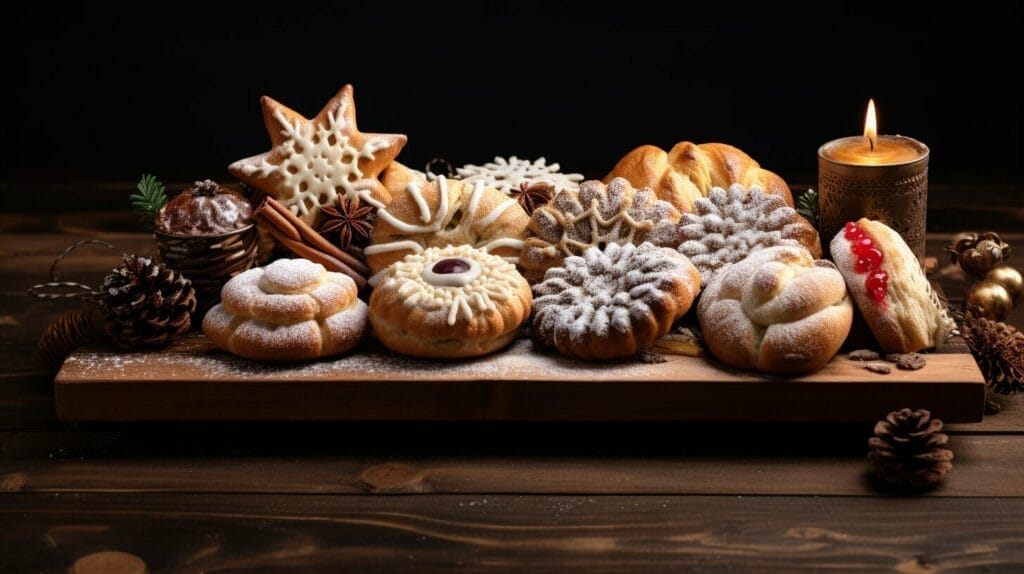
Another beloved Christmas treat in Hungary is gingerbread cookies, which are often intricately decorated with colorful icing. The gingerbread-making tradition in Hungary dates back centuries, and many families have their own treasured recipes that have been passed down through generations.
During the holiday season, it is common for families to come together to make gingerbread cookies and other festive sweets. This is a fun way to carry on cherished traditions and spend quality time with loved ones.
Hungarian Yule Log Traditions and Sweet Delights
Hungarian Yule log traditions date back centuries, and they are still cherished to this day. The Yule log, or ‘karácsonyi fatörzs’, is a special log that is burned in the fireplace on Christmas Eve. This tradition symbolizes the warmth and light that the birth of Jesus brought to the world.
To make the Yule log extra special, Hungarians decorate it with Szaloncukor, a type of Hungarian candy that has become a Christmas staple. These colorful candies are often hung on the Christmas tree as ornaments and are also given as gifts. They come in a variety of flavors, from fruity to nutty, and are sure to satisfy any sweet tooth.
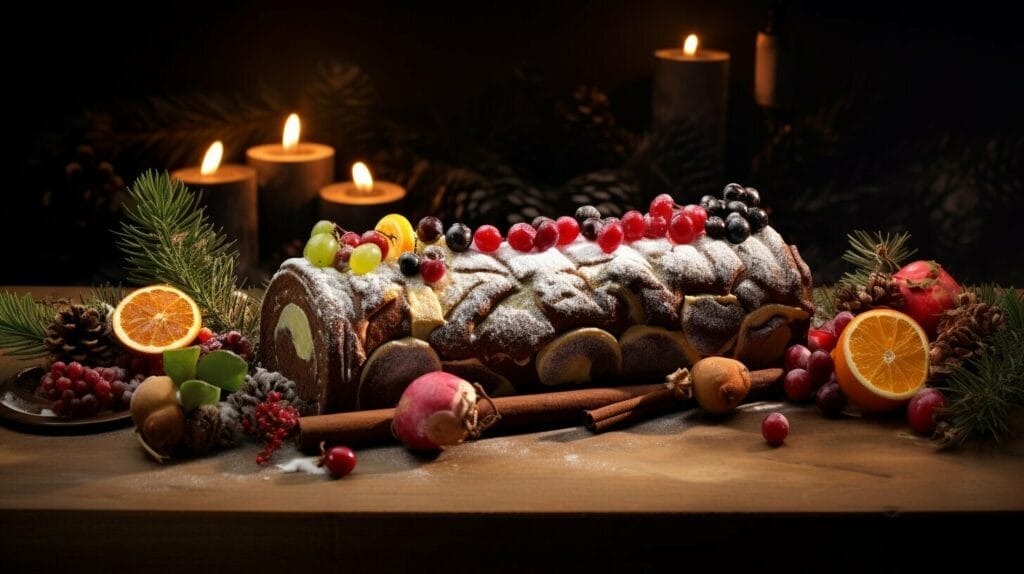
Aside from the Yule log, there are plenty of other sweet delights to indulge in during the holiday season. Beigli, a rolled pastry filled with poppy seed or walnut paste, is a beloved Hungarian Christmas treat that is often served after dinner on Christmas Eve. For those who prefer something less crunchy, there are plenty of traditional Christmas cakes and pastries to sink your teeth into.
Whether you’re munching on Szaloncukor or enjoying the rich flavors of Beigli, Hungarian Christmas traditions are sure to satisfy your sweet tooth.
Hungarian Midnight Mass and Epiphany Celebrations
Attending midnight mass on Christmas Eve is an integral part of the Hungarian Christmas traditions. The solemn midnight ritual involves the family coming together to celebrate and thank God for their blessings. The Hungarian midnight mass is a beautiful ceremony complete with heartwarming hymns, carols, and candlelight.
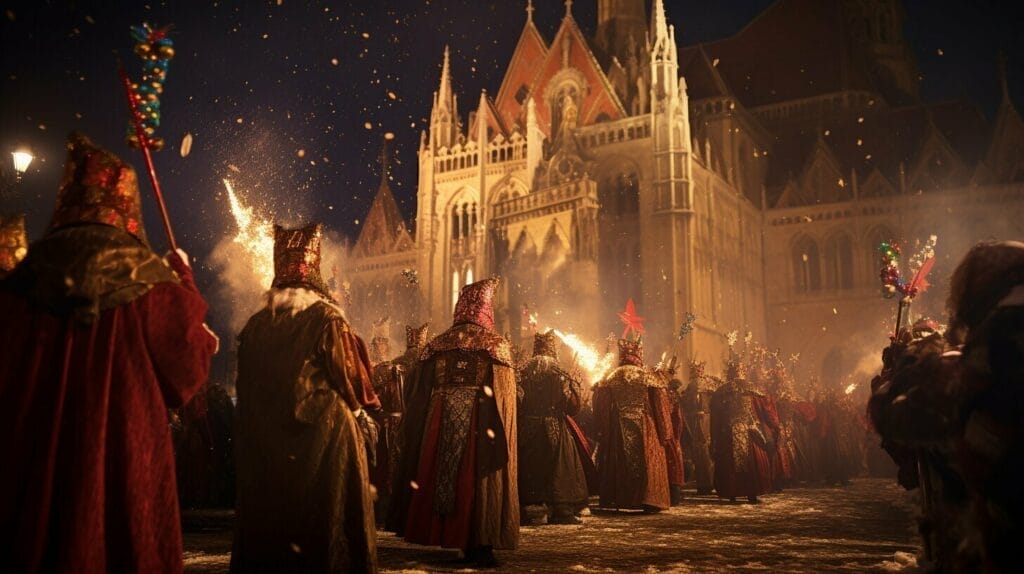
The Epiphany celebration marks the end of the Christmas season and is also a significant event in Hungary. On January 6th, also known as Three Kings’ Day, Hungarian families commemorate the Magi’s visit to the baby Jesus. It is customary to bless the home by sprinkling holy water in each room and sharing a traditional pastry known as Koronázás torta, which translates to Crown Cake.
The Magi are central to the Epiphany celebration, and their journey is depicted through the creation of intricate manger scenes. These depictions of the Nativity story and Bethlehem represent the Hungarian creativity and craftsmanship, with many small towns and villages competing for the most elaborate and creative design.
Epiphany in Hungary is a joyous event marked by the exchange of gifts and traditional sweets. It is customary to give money or small gifts to children dressed up as the Magi, also known as the Star Singers. These children go door to door, singing and reciting verses to bring blessings to each household.
Traditional Family Gatherings and New Year’s Customs
For Hungarians, the festive season is a time for family, with gatherings centered around Christmas Eve and Christmas Day. It’s a time to come together and celebrate the joys of the season, sharing traditional dishes and creating lasting memories.
New Year’s is also an important time for Hungarians, with many customs and traditions to mark the occasion. One such custom is the chime of the clock at midnight, which is celebrated with fireworks and champagne toasts. It’s also customary to make noise, often with the clanging of pots and pans, to drive away any negative spirits from the previous year.

Another tradition is to eat lentil soup on New Year’s Day, as lentils are believed to bring good luck and prosperity in the coming year. Additionally, many Hungarians also attend mass or watch the annual fireworks display held in Budapest.
Whether it’s spending time with loved ones or observing longstanding customs, the festive season in Hungary is truly a time of warmth and togetherness.
Family is the cornerstone of Hungarian culture, and this is especially true during the festive season. Traditions such as baking Christmas cookies, singing carols, and exchanging gifts only add to the sense of togetherness. Make the most of your time with family this holiday season and discover the unique customs that make Hungarian celebrations so special.
Hungarian Festive Beverages and Ornaments/Crafts
During the holiday season, Hungarians love to indulge in festive beverages that bring warmth and comfort to the chilly winter nights. Mulled wine, called Forralt bor, is a popular drink made with red wine, spices, and sugar. It’s served hot and is perfect for sipping while strolling through the magical Christmas markets.
If you’re looking for something a little stronger, try Palinka, the Hungarian fruit brandy. It’s typically made with plums, apricots, or cherries and is the perfect drink to enjoy with friends and family during the holidays.
When it comes to ornaments and crafts, Hungary is renowned for its exquisite handcrafted items. Hungarian Christmas ornaments are often made of glass, wood, or porcelain and feature intricate designs and vibrant colors. These ornaments are a beautiful addition to any Christmas tree and make a great souvenir to take home.
One of the most popular Hungarian crafts is the Herend Porcelain figurine. These delicate pieces are hand-painted and showcase the artistry and craftsmanship that Hungary is known for.

Whether you’re looking for festive beverages to warm you up or unique ornaments and crafts to take home, Hungary has something for everyone during the holiday season.
Hungarian Star Singers and Manger Scenes
One of the most cherished Hungarian Christmas traditions is the tradition of the star singers. Children dressed in costumes and carrying a star on a pole go from house to house, singing the Nativity story and wishing the household peace and prosperity. As they sing, they collect donations that are given to charity.
The manger scene, or Betlehemezés, is also an important part of Hungarian Christmas traditions. These scenes, which depict the birth of Jesus, are often intricately crafted and can be found in homes, churches, and even public squares. The scene typically includes figures of Mary, Joseph, and the baby Jesus, as well as the Three Wise Men, angels, shepherds, and various animals.
The manger scenes are often surrounded by decorations such as lights and traditional Hungarian crafts like painted eggs and gingerbread ornaments. These scenes serve as a reminder of the true meaning of the Christmas season and are a beautiful reflection of Hungarian culture and traditions.
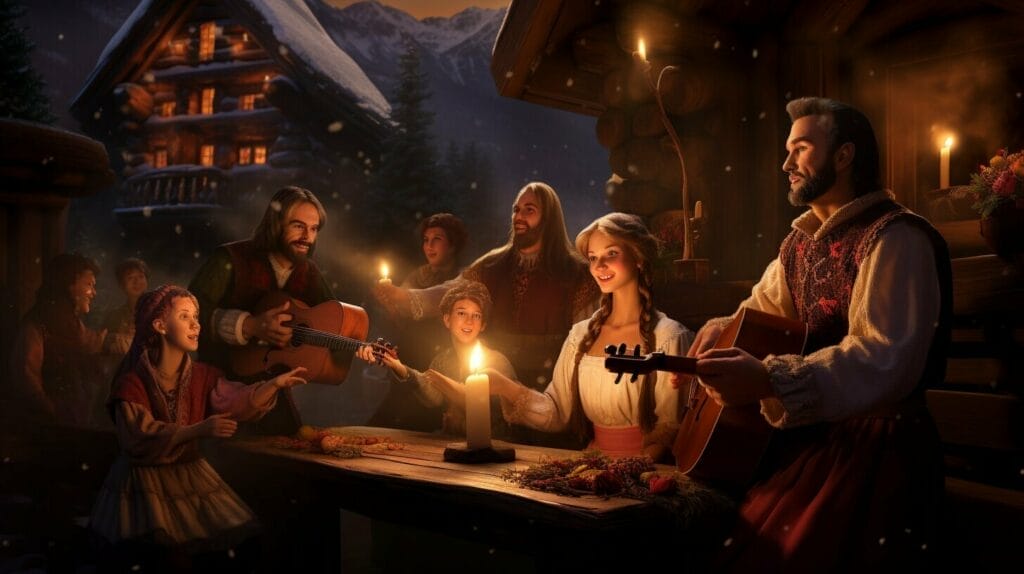
The star singers, or Betlehemesek, are young children who carry a large star on a pole as they go from house to house, singing carols and spreading joy and goodwill. The tradition dates back to 17th-century Hungary and has become an important part of the country’s Christmas celebrations.
The star singers are dressed in traditional costumes, often including animal skins and hats adorned with feathers. They sing a number of traditional carols, including “Angels We Have Heard on High” and “Silent Night,” as they make their way through the streets.
FAQ
What are some Hungarian Christmas Eve traditions?
Hungarian Christmas Eve traditions include decorating the Christmas tree, attending midnight mass, and enjoying a festive meal with family and friends.
What is Mikulás: Saint Nicholas Day?
Mikulás, also known as Saint Nicholas Day, is celebrated on December 6th in Hungary. It is a day when children receive small gifts and treats from Mikulás, similar to the concept of Santa Claus.
What are some traditional Hungarian Christmas dishes?
Traditional Hungarian Christmas dishes include Beigli, a Hungarian poppy roll, and Halászlé, a fisherman’s soup. These dishes are often enjoyed during the Christmas season.
What are the customs surrounding the Hungarian Advent wreath?
Hungarians decorate their homes and Christmas trees with Advent wreaths during the holiday season. The wreaths symbolize the countdown to Christmas and are often adorned with candles and ornaments.
What are some Hungarian festive folk songs and carols?
Hungarian festive folk songs and carols are an integral part of the holiday season. These traditional melodies bring joy and warmth to the festivities in Hungary.
What are some gift-giving Hungarian customs?
Hungarian gift-giving customs include exchanging presents on Christmas Eve or St. Nicholas Day. Christmas markets in Hungary also offer a wide array of handmade crafts and festive treats for gift shopping.
What are Hungarian Yule log traditions?
Hungarian Yule log traditions involve burning a log in the fireplace on Christmas Eve. The log symbolizes the warmth and light of the holiday season. Szaloncukor, Hungarian candies, are also hung on the Christmas tree.
What are some Hungarian Christmas pastries and gingerbread traditions?
Hungarian Christmas pastries are a delight for the taste buds, and gingerbread cookies showcase intricate designs. These traditional treats are a testament to the artistry and craftsmanship during the holiday season.
What are the rituals of Hungarian midnight mass and Epiphany celebrations?
Hungarian midnight mass is a solemn and awe-inspiring ritual held on Christmas Eve. Epiphany celebrations mark the end of the Christmas season, and various customs and traditions are observed during this joyous time.
What are some traditional family gatherings and New Year’s customs in Hungary?
Traditional family gatherings in Hungary during the holiday season are intimate and heartwarming. New Year’s customs include celebrating with loved ones and observing unique traditions specific to Hungary.
What are some Hungarian festive beverages and ornaments/crafts?
Hungarian festive beverages include traditional drinks that warm the hearts during the holiday season. Ornaments and crafts from Hungary showcase exquisite craftsmanship and add a touch of magic to the festivities.
Who are the Hungarian star singers, and what are manger scenes in Hungary?
Hungarian star singers are a group of children who bring the joy of Christmas through their singing. Manger scenes in Hungary depict the birth of Jesus and the Nativity story, adding a beautiful element to the holiday season.
What are Hungarian festive folk dances and traditional attire?
Hungarian festive folk dances are a vibrant and lively part of the cultural heritage. These captivating performances are enhanced by the traditional attires worn by the dancers, adding elegance and charm to the celebrations.




